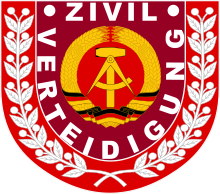This article needs additional citations for verification. (June 2020) |
You can help expand this article with text translated from the corresponding article in German. (June 2020) Click [show] for important translation instructions.
|
The Civil defense of the GDR (German: Zivilverteidigung der DDR) was an organization for the protection of the population, the economy, vital facilities and cultural values against the consequences of disasters and accidents.[1] In the event of war, it should also serve to protect its own population from military operations.


The beginnings of civil defense in Germany go back to considerations after the First World War that the democratic constitutional state must be defended in peacetime and should include the non-military part of defense. It was possible to build on experience in disaster protection. In addition, the knowledge gained during the Second World War from air raid protection, fire services, medical services, etc. was incorporated.
The members of the civil defense were trained at appropriate “district schools ZV”. In addition, the GDR Civil Defense Institute existed in Beeskow as the highest teaching institution for GDR civil defense. In 1979 the institute received university status. The last commander of the institute was Major General Albert Pankau.
At universities and technical schools in the GDR, knowledge and skills for carrying out civil defense tasks were imparted as part of vocational training. Civil defense was part of military instruction at the polytechnic and extended high schools.
In conjunction with other measures to protect the population of the GDR, the creation of institutions and management structures to combat disasters began in the 1950s. Special platoons and squads were formed in the fire department, but these were separated from the fire department in 1956.
The Active Fire Protection Administration was created at the departmental level in the Ministry of the Interior (MdI). Working groups have been set up at district council level. The senior officials received appropriate training at the USSR air defense training institutions. On February 11, 1958, the GDR People's Chamber passed the Air Raid Protection Act as the basis for later civil defense. In the period that followed, air defense staffs and operational groups were formed in the ministries, the councils of the districts, districts, municipalities, and economically important companies and institutions. The aim was to set up a warning system, set up air raid formations, create reserves to supply the population and create shelters.
The Civil Defense Act of September 16, 1970 was intended to take into account the increased demands for protecting the population and securing vital areas, even in the event of war. Accordingly, the following civil defense forces were set up: rescue, recovery, repair, detoxification, medical, supply, reconnaissance and equipment formations as well as special facilities for sanitary treatment and deactivation, first medical aid groups, observation points. The formations were divided into platoons, groups, departments, standby teams and emergency force staffs.
Leadership
edit| Rank, name | Period of service | Role |
|---|---|---|
| Generaloberst Fritz Peter | 1976–1990 | Head of civil defense in the GDR |
| Generalmajor Rudi Schütz | 1978–1986 | Deputy Head and Chief of Staff |
| Generalmajor Werner Zaroba | 1986–1990 | Deputy Head and Chief of Staff |
| Generalmajor Rolf Fischer | 1976–1990 | Deputy Head and Chief of Civil and Economic Protection |
| Generalmajor Klaus Rude | 1978–1990 | Deputy Head and Chief Training |
| Generalmajor Kurt Sommer | 1977–1990 | Deputy Head and Head of Political Administration |
See also
editReferences
edit- ^ Wörterbuch zur deutschen Militärgeschichte [Dictionary of German Military History] (in German). 1985. p. 1101.